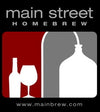
The House of Flying Malt
It was many years ago, not long after my training in the Brewing Arts had been completed. I was living in isolation, alone, in an inaccessible valley, in a snowy mountain cabin, contemplating the Inner Mysteries of the Malt.
It was in the middle of a boil that my peace was disturbed, and my life was forever altered.
I never heard him enter. Like a shadow, he slipped across the pine boards of my shack until, by good fortune or bad, the steam from my boil pot wrapped around him, revealing his dark outline. He stepped into the flickering glow of my fire.
Before either of us could blink, we both leapt. My spoon fluttered over the tips of my fingers and clicked on the edge of the brew pot, barely catching a small piece of Belgian candy sugar that he had tried to add. Our eyes locked, and he nodded in respect.
I didnʼt know who he was, but his training was evident. He knew how to brew, perhaps more than I did. I bowed to the stranger, knowing what must happen next.
“Your beer-fu is strong,” I admitted. “Your Master has taught you well.” I ripped off my beer apron.
“But so has mine...”
The room was instantly filled with green debris as I flung ounce after ounce of hop cones at the boil pot. Like a phantom - in slow motion - he sidestepped and back-bent, dodging and spinning, evading each piece of my attack until my bags were empty.
When it was over, he stood and turned to face me. Between thumb and forefinger he held a single green cone. “You have chosen Chinook, Brewer-san.” His eyes narrowed. “Perhaps you should study your styles more closely.” His hands flew up over his head and froze. “Let me show you the Way of Tettnang.”
His hop additions were furious, and for thirty minutes I countered each one with more malt and darker crystal. Then, finally, his hop bags were empty. He smiled, thinking it was over, that he was victorious. We faced each other in silence, the only sound were the drops of sweat dripping from our brows onto the cracked floor.
From inside my robe I slowly pulled out my yeast: London Ale.
“I thought you might come tonight,” I told him.
In desperation he flipped the table on its side, spraying crystal malt and roasted barley across the room. He fumbled for his gypsum, but we both knew it was too late. He had been a worthy adversary. I leapt across the room, grabbing his wrist as he struggled for the Irish Moss. Something wet and sticky oozed down my temple and onto my cheek. I touched it with my finger and then, staring into his eyes, brought it slowly to my tongue.
“Wheat Malt Extract?” I laughed. “Did you not realize I was brewing Stout?”
And just as he had appeared, he was gone. I finished my boil and left the mountains, never to look back. For many years I wandered; in time reaching that mythical Land of Microbrews and Beer Appreciation. But that is a story for another day.
BLACK BELT STOUT
A dark, roasty, bitter ale.
9.9 pounds Amber Malt Extract
8 ounces 120L crystal malt
8 ounces chocolate malt
8 ounces roasted barley
8 ounces Carafa II (black) malt
1.0 ounce Chinook hops.............60 minutes
0.5 ounce Chinook hops.............20 minutes
0.5 ounce Chinook hops.............10 minutes
White Labs London Ale, Imperial Darkness, or SafAle SO-4,
or Yeast of Choice
Bottle with 3/4 to one cup of corn sugar, depending on carbonation preferences.





